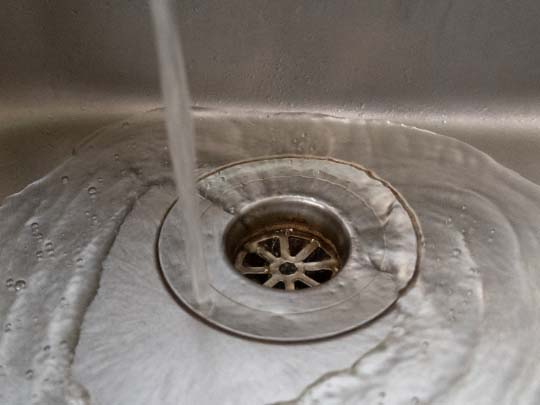[ad_1]
Wet areas can be the site of all sorts of household crises, from leaks to mould. Regular maintenance is a must.
We spoke to the founder and owner of Metropolitan Plumbing, Electrical and Air Conditioning, David Ellingsen, to understand some of the key signs your kitchen or bathroom could be due for repair.
1. Your sink is gurgling
One sign that there’s a block in your pipes is if your drains are making a gurgling sound.
“Blocked drains in the kitchen often occur because food scraps, oil and grease build up in the drain — this results in poor drainage,” David says. “You will most likely hear loud gurgling from the kitchen sink, while there are often unwelcome odours that also emanate.”

In the bathroom, common drain blockages include hair and soap scum — try to have a filter to catch hair.
Meanwhile, toilet blockages are a whole other story. The best way to avoid a blocked loo is by not flushing anything you’re not supposed to.
“The appropriate fix will include use of a plunger, a drain auger or a comprehensive hydro jet drain clean that breaks up stubborn blockages and washes the waste away to the sewers,” David explains.
2. Suspicious spots on your walls
There are two types of spots or stains that you may discover on walls — removable scuff marks or those that set in over time.

If there are spots or stains forming on your walls, ceiling or floors, that’s a sign of moisture build-up — a potential sign that your pipes could be leaking.
“You might also notice a musty smell or, if it’s severe enough, there might even be mould and mildew,” David adds.
One way to check if your pipes are leaking is to shut off the mains to your home and see if your water meter is still running. You might also receive a hefty bill that doesn’t match your water usage, David notes.
3. Chipping paint or efflorescence
“Rising damp occurs when moisture from underneath a home seeps into the internal walls via the ground,” David explains. “It can be a costly problem that destroys foundations and leads to harmful mould and bacteria growth.”
While the most common sign of rising damp is probably a stain that appears to be ‘rising’ up your walls from the floor, chipping paint or efflorescence are two other warning signs to heed.
Inside, rising damp may look like paint bubbling, flaking or chipping off your walls and the wall looking as though it’s rotting.
If you have a brick home, you might see it outside via a white, chalky powder coating your bricks. This is caused by moisture moving through the brick, leaching minerals out from within the material to form salt deposits. This is known as efflorescence.

“Rising damp can be a costly problem that destroys foundations and leads to harmful mould and bacteria growth,” Davis says.
“Modern homes all feature a black polyethylene sheet around ankle height, a physical damp-proof course. However, it’s difficult to retrofit older homes without extensive, costly work.
“The best treatment for rising damp is to create a new damp-proofing course throughout the home. You have to stop the spread of moisture in its tracks. Modern processes include drilling into brick and masonry before filling the gaps with a damp course cream of fluid. It’s a strong watertight barrier against rising levels of moisture.”
4. No hot water
No one likes it when the hot water runs out. But before you start blaming other household members for long showers, it could also be a sign something is wrong with your hot water heater.

“Before calling a professional, make sure the hot water system is still receiving electricity or natural gas, that the pilot light is still lit and that the valves remain open,” David says.
“Further issues warrant the aid of a plumber who can check that the hot water system’s thermostat works correctly and check for further malfunctions. A leaking system can also be the issue and this should be obvious through signs of pooling water.”
David adds that older units approaching 10 years of age are likely to have recurring problems compared to new hot water units.
“Prevention is your best bet for a long-lasting hot water system,” he says. “Have a plumber come out for an annual service and they can make sure it’s in tip-top shape so you can get the most out of your system.”
5. Poor water pressure

There can be many reasons for poor water pressure, but David outlines a few of the more insidious ones:
“Leaking or clogged pipes can reduce the pressure, so can corroded pipes and fixtures. The water pressure regulator could fail or possibly the old pipes are the incorrect size for modern fixtures and hot water systems. Or it might just be a cheap or water saving shower head that can’t achieve the desired pressure and so it might be time to upgrade.”
6. Old, leaky taps
Newer taps can leak too but David finds leaks less common in modern mixer taps as they don’t have washers or o-rings.

“The common cause of leaking taps is attributed to the internal o-ring or washer failing — it’s likely that this seal has worn away and allows water to seep through,” he begins.
“But the problem could be any number of causes including loose parts from poor installation or years of use. The problem could also be excessive water pressure. Australian standards dictate that water pressure cannot exceed 500 kPa. The pressure can lead to serious damage if left untreated. Early warning signs include leaks and banging within the pipes.”
Whatever the issue, be sure to call yourself a plumber.
All pictures are courtesy of Metropolitan Plumbing.
The post 6 signs your kitchen and bathroom need maintenance appeared first on realestate.com.au.
[ad_2]
www.realestate.com.au










